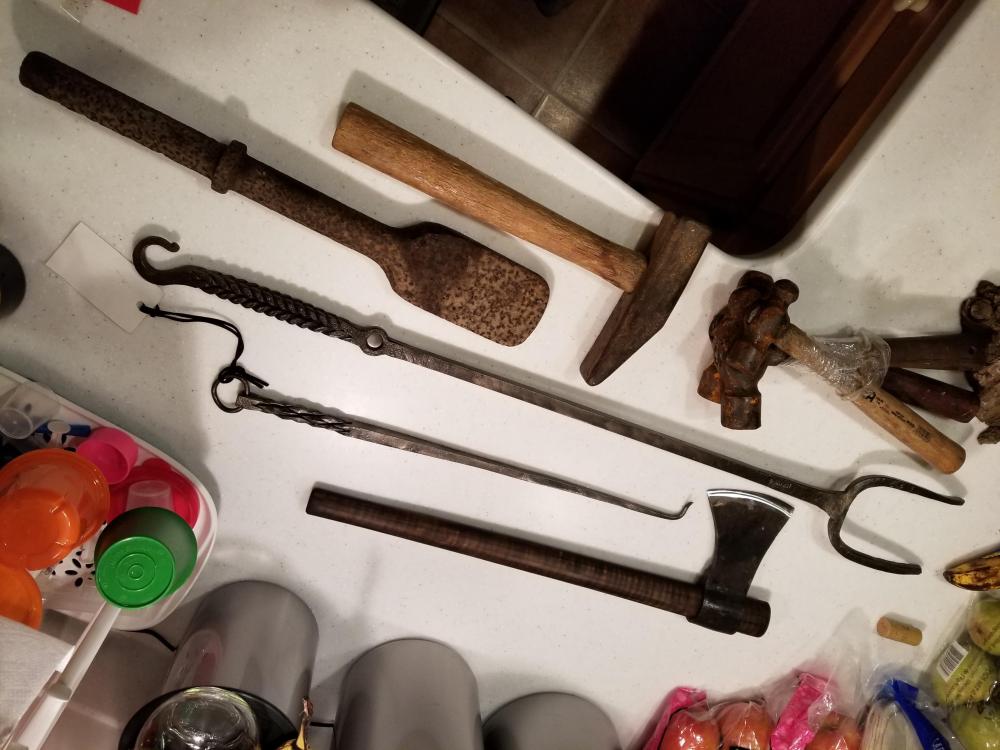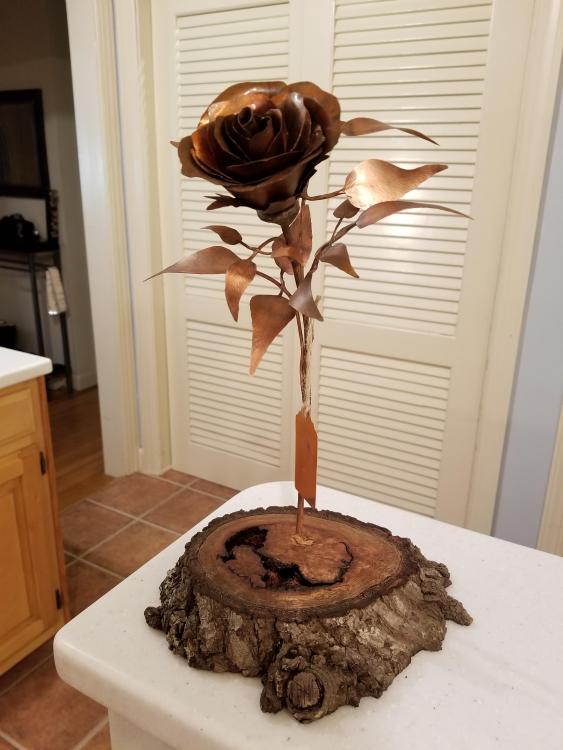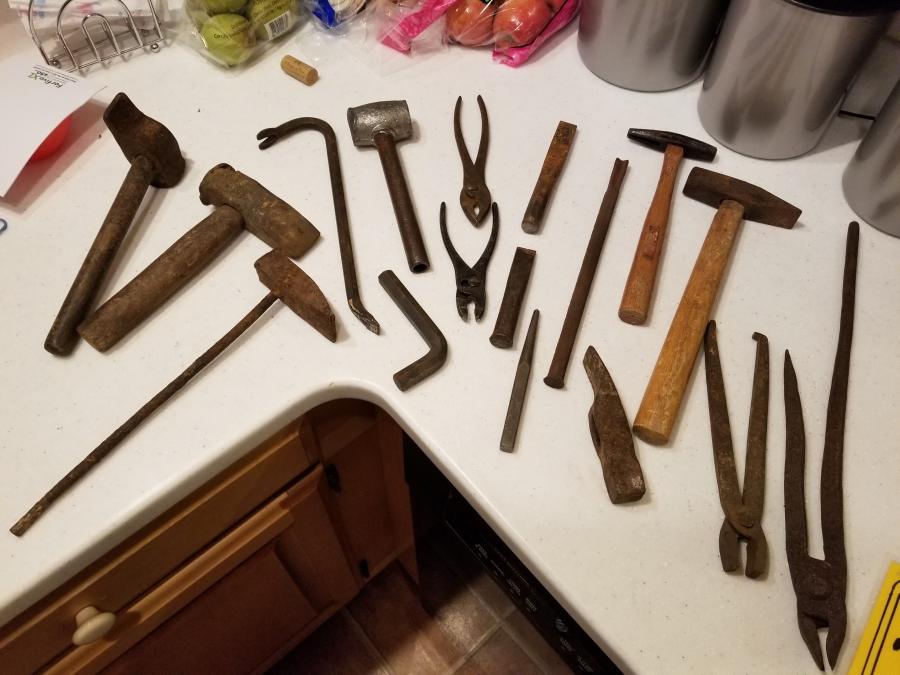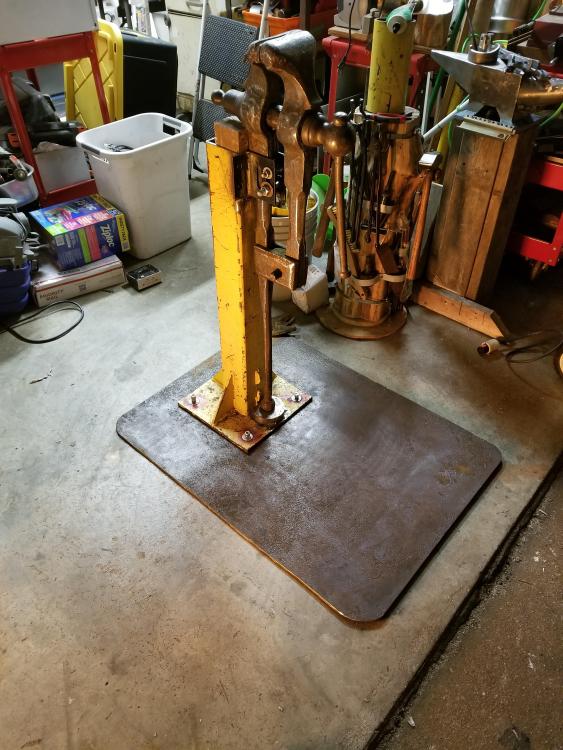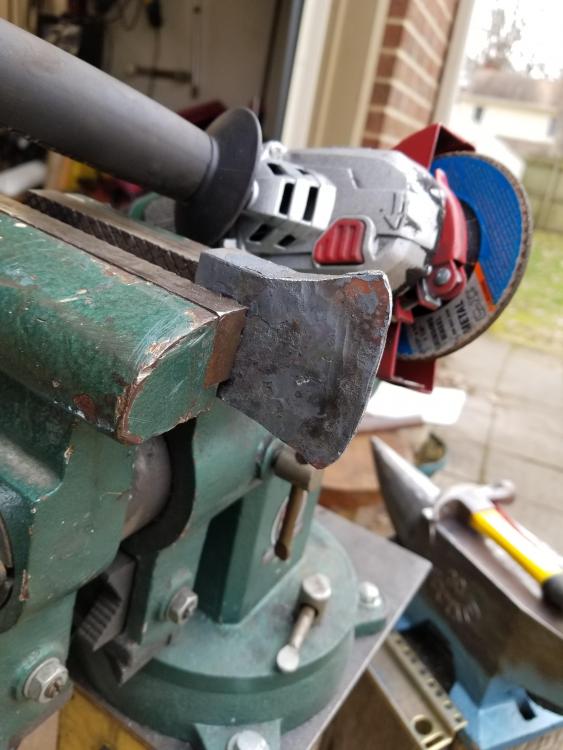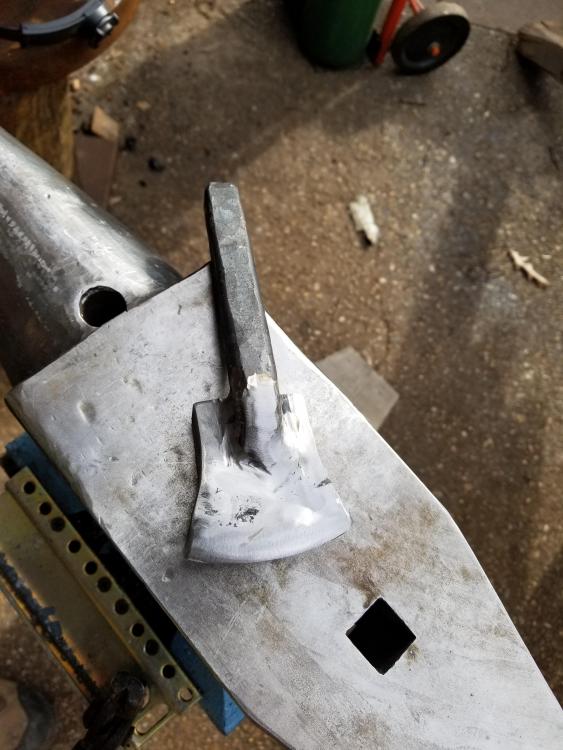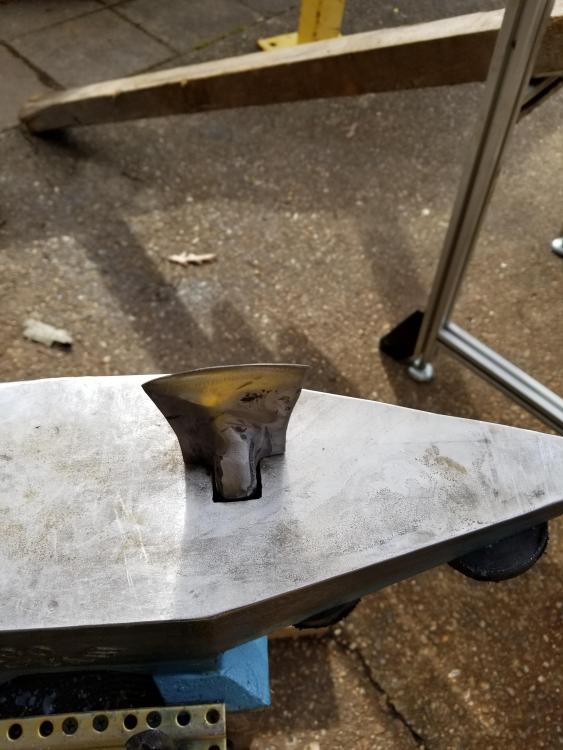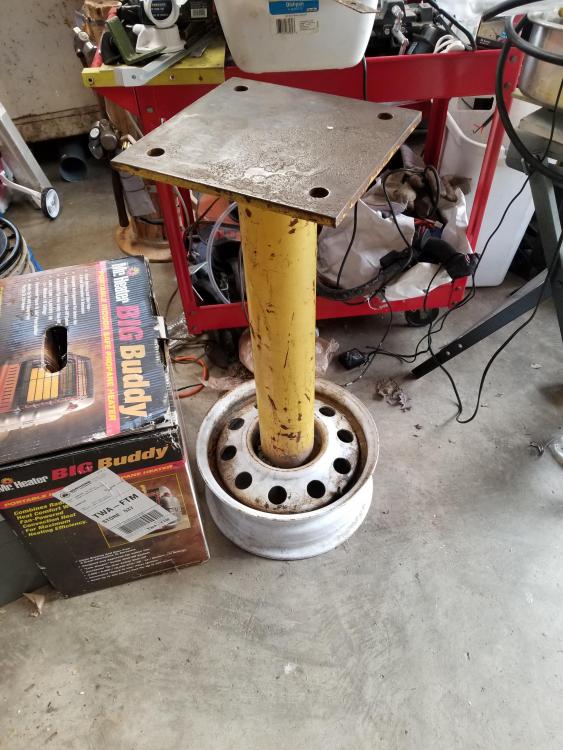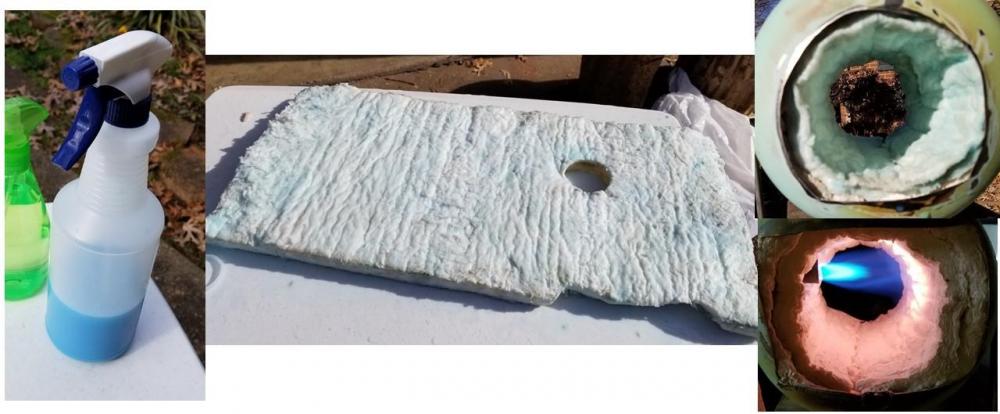-
Posts
290 -
Joined
-
Last visited
Content Type
Profiles
Forums
Articles
Gallery
Downloads
Events
Everything posted by HojPoj
-
And judging from the size, big enough to be a hammer eye punch.
-
Went to the Boone Pasture Party today, and won a few things at the Iron-In-The-Hat. The humongous flesh fork has a double wheat twist on the handle, the steak turner a pineapple twist. And for a reasonable sum of money I got this from someone's boxes of junk- er, stuff: I'm starting to think I need to cobble together an electrolytic cleaning vat.
-
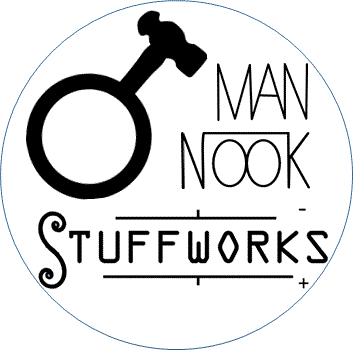
What did you do in the shop today?
HojPoj replied to Mark Ling's topic in Blacksmithing, General Discussion
Really just depends on your situation- if you've got plenty of refractory why go through the time and expense of buying more stuff? If you'd have to buy more stuff anyways, might as well just buy what'll do the job well for minimal hassle. -

What did you do in the shop today?
HojPoj replied to Mark Ling's topic in Blacksmithing, General Discussion
It's likely to be a better choice for a consumable floor than a standard dense firebrick so long as the chosen refractory has adequate mechanical and chemical resistance. The biggest advantage is that you can tune it for your forge (no cutting a brick), your work (special features, like a plinth, perhaps?), and the other parameters. On my casting furnace I took my dense castable and added shredded Styrofoam to it in order to increase its insulative properties without seriously compromising its other characteristics (the foam burns out leaving air voids, and no fluxing residue). You could do a cast all in one go with a foamed bottom and a skim coat of the same refractory for a wear surface (and without the different coefficients of thermal expansion that you'd find with using two different refractories). That being said, I personally would still do an open top casting instead of a bag just to avoid the wrinkles. A quick lining with plastic wrap would probably do the job just as well. The bag's certainly a lot less fuss n' muss, though. -
I'll second what JHCC said. They're a little spendy, but I'd order at least one pair of commercial tongs that'll fit the type stock you'll be using most (or something that's so-so for general use, like wolf jaw tongs). This'll give you the benefit of something that you *know* will work, and also gives you something to have in your hands to dissect the process of making them and what geometries you might prefer.
-
If you're at a pottery supply place you could just ask for a high-fire clay. Whatever's cheapest will do the job. If there isn't one near you, the only other places I'd check would be a brick yard. Unfortunately fireclay doesn't have the ubiquity of bentonite, so the sources are more limited.
-
I didnt see that acknowledgement of the mid-heating, but I'm not all with-it today. Generally you want a little fuel to also be on top of the workpiece, this insulates the metal and provides for a faster, more even heating. At very high temperatures like this heat loss through radiation is what dominates. The roof you made helps a little, but not nearly enough to be worth such an obstruction. If you try the trench you could just have the roof going inline with the tuyere. Also, 'trench' implies something bigger than it really is, if memory serves it's only like 4-6" wide by 8" long.
-
So would a Congress be applicable to a collection of bellows/blowers, Thomas?
-
Looks like you're off to a good start, and already learned some of the lessons in what to change along the way. Charles (Originator of the JABOD) often states that a trench perpendicular to the tuyere seems to work well for charcoal, only comment I'd provide is that the width (from tuyere end to opposite wall) seems a bit too much, you may want to bring that a little closer (Yeah, I know it doesn't work well with the standard dimensions of the firebrick, maybe split one in half?). Plus, unless you're only doing stuff on the tips of the stock, you may want to reconfigure for the ability to pass stock across the fire.
-
1) any clay that can stand the heat. Fire clay can be gotten at pottery supply places. 2) yes, usually in a slow, controlled manner to avoid cracks as it shrinks. 3) Depends on the application.
-

What did you do in the shop today?
HojPoj replied to Mark Ling's topic in Blacksmithing, General Discussion
Finally got my post vise onto the Mk I mount. I know it will need some additional bracing, but it's a reasonable start for what I do. Unfortunately I dont have anything/place permanent for it to go, so its stand has to be moveable (to head off the arguments about fixing to a post in the ground or bolted into the concrete, etc.). -
If memory serves, Morse taper is only in the 1.5 to 3 degree range, by the way.
-
"We earnestly strive to help new smiths to make new and improved mistakes rather than just repeating the old ones we have proven in so many times before!" ~ThomasPowers
-
Depends on what you want to do with the surface grinder. For best results (and most accurate finish) you'll want the power to be true 3-phase, and variable speed shouldn't buy a whole lot on a surface grinder anyhow. A rotary phase converter would be ideal, with a VFD being second choice. If run on 220V the motor may not run at the rated speed, and as already identified there may be some issues with the control circuit voltages. For those wondering why a static phase converter is a bad idea, with one missing leg there are oscillation in the applied power that will actually show up in the surface finish on a surface grinder, it's also why a 3-phase motor is more desired for driving the spindle than a single phase- the applied power is less variable ("smoother").
-
Hah! That's pretty awesome ausfire!
-
Or just talk to any custom glass place, that small a size should be easy enough for them to cut off from scraps. Some experimentation may be required, I don't know what camera you're using or what its autofocus mechanism is. Some cameras don't like the AF sensors being covered by anything as it causes them to misfocus- not enough to notice on-camera, but it'll show in the post-production.
-

What did you do in the shop today?
HojPoj replied to Mark Ling's topic in Blacksmithing, General Discussion
Mine was 4 layers, 4 petals/layer. -

What did you do in the shop today?
HojPoj replied to Mark Ling's topic in Blacksmithing, General Discussion
Yeah, there's a couple rental places I haven't checked yet, but I'd looked into the home depot rentals after reading about it here. -

What did you do in the shop today?
HojPoj replied to Mark Ling's topic in Blacksmithing, General Discussion
I already tried, the guy said they send them to Georgia for reconditioning. So no joy on buying. -

What did you do in the shop today?
HojPoj replied to Mark Ling's topic in Blacksmithing, General Discussion
Sadly my scrapyard doesn't typically have those sorts of things. I've got a few candidate things (like a fat bolt) that I need to test, but i had cut the materials i used a few days prior. Need to make some gifts to make friendly with some mechanics other than the ones at the airfield- efforts thus far have been unsuccessful. -

3D printed plastic burner experiments (photo heavy)
HojPoj replied to Another FrankenBurner's topic in Gas Forges
Well, since we're on the topic of jets, has anyone attempted using a 3D printer nozzle as an orifice? The common sizes range from .2mm up to 1.0mm in 0.1-0.2mm increments. They don't have a long diametral transition, so the flow out the tip is likely to be turbulent, but dang if they're not cheap (and get to *really* small sizes!).- 863 replies
-

What did you do in the shop today?
HojPoj replied to Mark Ling's topic in Blacksmithing, General Discussion
Played hooky from work and did a few things: Made my first hot cut (unfortunately all mild steel still rummaging for the right size alloy steel that lets me avoid excessive upsetting or drawing out). Shaped the body, welded on a shank (squared up some 7/8" round), and it's sittin' pretty. Haven't gotten to use it yet, though. Also checked out a scrapyard I'd not been to before, didn't get anything, but did nab a few things from my regular one. Made up a new portable stand for my bench vise by flipping the round stanchion and welding it to the rim. Still gotta do the mounting for the vise and the short stock storage in the base (for additional weight). -
Depending on the MIG tip type you get it may be metric. The ones from harbor freight for their cheap flux core welders are an M6 thread form. Pretty darn close to a 1/4 thread, just depends on how easy you wanna screw it in.
-
JHCC, do you have a picture of what your mix looked like? When I rigidized mine the color was very faint on the wool, still seems to have firmed it up. Yours was a MUCH darker blue than I ended up with, wasn't sure if you added more colorant, or just used a whole lot more rigidizer than I did.

